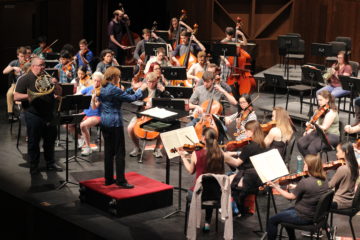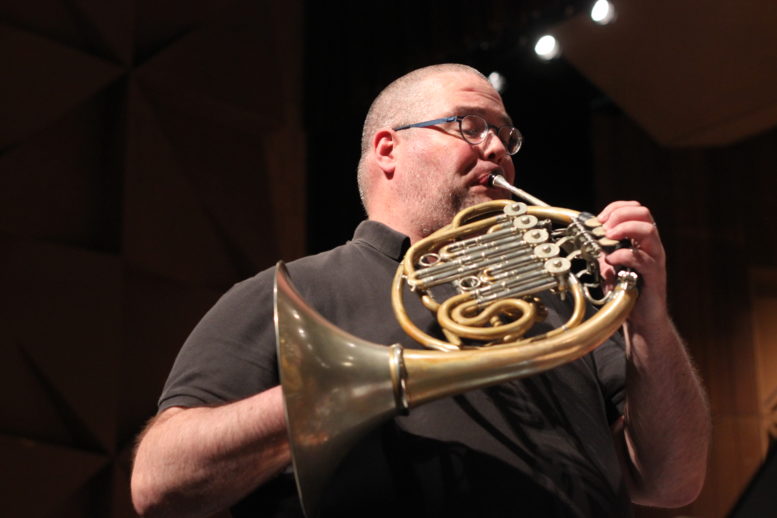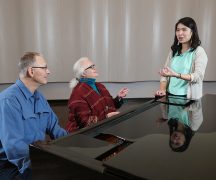By DAVID DUPONT
BG Independent News
For French horn players, there’s no escaping the four Mozart concertos.
Andrew Pelletier, professor of horn at the College of Musical Arts, has played the fourth Horn Concerto as many as nine times with full orchestra, and he doesn’t know how many times with just piano.
And it is a staple of the repertoire for his students. They know whenever they go out for auditions, whether for scholarships, competitions, graduate school admission or orchestral work, movements from the second and fourth will be required.
Their soaring melodies, flourishes and ebullient calls serve as the foundation of the instrument’s literature.

Pelletier will perform Mozart’s Horn Concerto in E-Flat Major with the Bowling Green Philharmonia Sunday, April23, at 3 p.m. in Kobacker Hall on the Bowling Green State University campus. The orchestra also will perform Brahms’ Symphony No. 2 and Stravinsky’s “Firebird” Suite.
The fourth of Mozart’s horn concertos is “the most involved” of the set, Pelletier said, with two cadenzas.
In Mozart’s time, Pelletier said, horn was the most featured wind instrument. The instrument had not long before come in from the field. The hunting horn made its first orchestral appearance in opera, whenever a hunting scene was involved.
Horn players of the time developed techniques to allow them to play more notes than the natural bugle-like overtone series. This enabled the horn to play virtuosic passages “and “beautiful singing melodies,” Pelletier said. “It’s the sound of the horn that captures so many different emotions that caught me.”
Mozart made full use of the instruments resources and associations. “Whenever I play Mozart I feel I’m never far from the opera,” Pelletier said. “It’s the human voice that happens to sound like a horn.”
The horn’s sound is what first captured Pelletier’s attention as a fifth grader growing up in Lewiston, Maine.
The brass quintet from nearby Bates College visited his school. Pelletier said he was showing off to his friends by identifying all the different instruments, until he got to horn. With all its strange tubing, he didn’t know what it was. And what was the horn player doing with his hand inside the bell? Then he heard it. “I felt like I was being hugged by the sound.”
The next year the Catholic school he attended acquired a horn, and he started lessons. “I fell in love with it right away.”
And in a few years, he was playing the slow movement of Mozart’s third horn concerto.
He had his first professional engagement at 17.
But he had not settled on a career in music. “I always felt this pull between music and the monastic life,” he said. “I was encouraged by my spiritual advisor to give music a go and, if it didn’t work out, I could always join the monastery. I’ve been doing this ever since.”
That means being engrossed by Mozart. “At some point horn players will make it through all four.”
The numbering is deceptive, though, he explained.
Ludwig von Köchel catalogued Mozart’s work. But, Pelletier said, “we don’t have authorized manuscripts” for the horn concertos.
So Köchel estimated the order based on his assessment of the musical sophistication of the pieces. So the simplest, seemingly less mature, concerto was one, while the most difficult, and seemingly more advanced, was the fourth.
In recent times, scholar John Humphries debunked that. He determined the fourth was written earlier than the first, which was actually the last to be finished.
The concertos were all written for Joseph Ignaz Leutgreb who played in Leopold Mozart’s orchestra in Salzburg before moving to Vienna. The scores, Pelletier said, are full of teasing notes and jokes directed as the soloist.
The fourth was written when Leutgeb was at the height of his powers. The first was written later in his career when he was in ill health, but still performing. Mozart left that incomplete.
And that adds to the fun of performing these, Pelletier said. “These were really personal. This was someone he really knew.”





